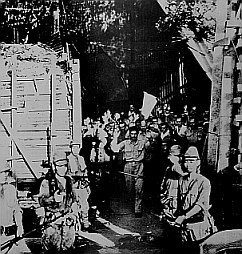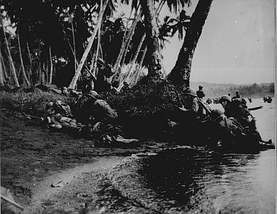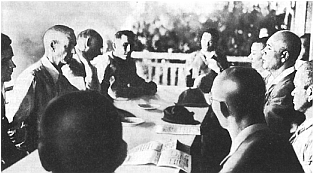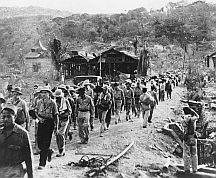World War II: Pacific Theater
|
Profiles
* Political Thought * Colonial Government * Revolution * Constitution * Birth of Party Politics * War of 1812 * James Monroe: "Era of Good Feeling" and Monroe Doctrine * Jacksonian Democracy * Regional Conflict and Compromise * 1860 Election of Abraham Lincoln * Civil War 1861-62 * Civil War 1863-65 * Reconstruction and Impeachment of President Johnson * Gilded Age and Progressive Era * 1912 Election of Woodrow Wilson * 1916 Election and World War I * Women's Suffrage * Depression and 1932 Election of Franklin D. Roosevelt * Prelude to World War II * Pearl Harbor and Mobilization * World War II: European Theater * World War II: Pacific Theater * Atomic Bomb and End of World War II * 1948 Truman-Dewey Election * 1960 Kennedy-Nixon Election * 1964 Johnson-Goldwater Election * Civil Rights Movement * Vietnam: Evolution of the American Role * Vietnam: Kennedy Administration and Intervention * Vietnam: Johnson Administration and Escalation * Vietnam: Nixon, Ford and Fall of South Vietnam * 1968 Humphrey-Nixon Election * Watergate Scandal and Resignation of President Nixon * 1976 Carter-Ford Election * 1980 & 1984 Reagan Elections * Clinton Impeachment * 2000 Bush-Gore Election * War in Iraq * 2008 Obama-McCain Election * 2016 Trump-Clinton Election |
|
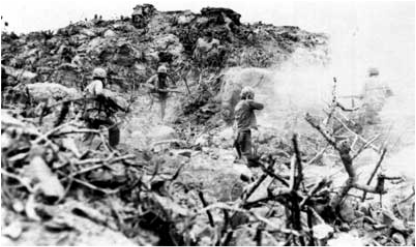 U.S. troops shown using flamethrowers against Japanese defenders hidden in caves on Iwo Jima
Image: National Archives U.S. troops shown using flamethrowers against Japanese defenders hidden in caves on Iwo Jima
Image: National Archives
In early 1944, the U.S. also took the islands of Kwajalein, Roi and Namur in the Marshalls chain. The loss of Saipan in July 1944, which was heavily fortified with 30,000 troops and considered by the Japanese as the key to the defense of their home islands, also provoked a political crisis leading to the fall of the government of Emperor Hideki Tojo. In a desperate effort to regain the initiative after the defeat on Saipan, the Japanese undertook a poorly-planned air attack on the U.S. fleet off the Marianas, losing over 400 planes to only 30 for the Allies. Without the protection of the carrier planes, the remaining vessels of the Japanese fleet became vulnerable to air attack and were forced to return to waters closer to their home islands.
Iwo Jima and Okinawa In the fall of 1944, the American bombing campaign was bolstered by the introduction of the new B-29 "Superfortress," a huge bomber capable of reaching the Japanese home islands. But Japanese fighters taking off from the island of Iwo Jima were intercepting B-29s, as well as attacking the Mariana airfields. To end the Japanese raids, after months of naval and air bombardment, U.S. Marines invaded Iwo Jima on February 19, 1945, confronted Japanese defenders dug into caves and bunkers deep within the island's volcanic rocks. In thirty-six days of fighting on the island, nearly 7,000 U.S. Marines were killed and 20,000 were wounded of the 70,000 in the battle. Over 22,000 Japanese soldiers were killed before the island was finally declared secure on March 16. The last amphibious landing of the war would commence on April 1, when U.S. Marines landed on the beaches of Okinawa. Less than two weeks later, President Roosevelt died in Warm Springs, Georgia. With the surrender of Germany in May, the final decisions on how to bring the war in the Pacific to a close would be left to President Truman. Given the extensive casualties suffered in taking both Iwo Jima and Okinawa (where 12,000 Americans were killed and another 50,000 wounded), Truman was confronted with whether to proceed with the invasion of the Japanese home islands or to use the new weapon which he had only learned of upon Roosevelt's death, the atomic bomb. See The Atomic Bomb and the End of World War II Resources
* A Brief History of the U.S. Army in World War II >> U.S. Army Center of Military History * "The War" >> PBS * National World War II Museum * World War II Archives >> WWII Archives Foundation, Inc. * WW II Archive >> Internet Archive * Inside WW II (video) >> National Geographic * World War II Records >> National Archives Education * "The War" (lesson plans) >> PBS * World War II (lesson plans and classroom resources) >> National World War II Museum * The United States in World War II: "The Proper Application of Overwhelming Force" (lesson plans) >> EDSITEment |
